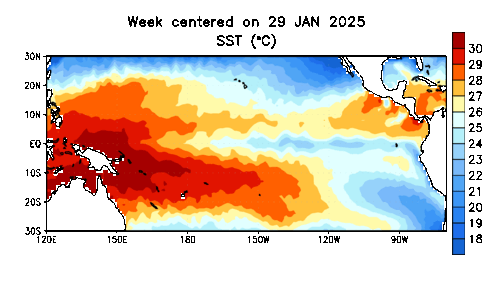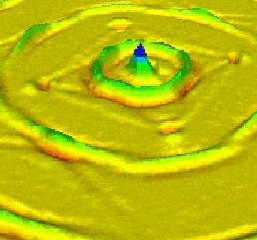Java Crop Circles highlight Earth Changes

Mount Merapi in Java, Indonesia: constantly active, the stratovolcano last erupted November 5th 2010
The second crop circle (January 25th) lies in the Bantul district of Yogyakarta, 6km south of the center (and the Kraton Palace) in a rural district which suffered severe structural damage and loss of life in May 27th 2006 when a 6.2 magnitude earthquake tore through the village. Bantul is known internationally as an important artist’s colony which produces posters using a technique called cukil, daren kidul and Dono Kerto Turi.
Crop circle followers worldwide are struck by the synchronicity of the crop circle sightings — these are unique in Indonesia; the first time crop circles have appeared — with their closeness in date, design and proximity to Mount Merapi’s seismic field. Even local Indonesians are contemplating the coincidence of the two designs’ choice of location as a warning of further earth changes in this volatile region. Within days, thousands of visitors lined up to walk through the rice fields to experience the phenomenon first-hand.Many had never heard of crop circles nor read of the phenomenon and several reports described the marks in the fields as the ‘imprint of landing UFOs‘.
In a statement from the Yogyakarta Sultanate by Java’s spiritual counsellor, HRH Prince Karyonagoro (Kandjeng Pangeran) the Sultan’s family is ‘taking these appearances seriously’.However the design of the circles has struck him as very interesting as it appears to replicate the form of the Javanese Muladhara, or the base chakra of the kundalini.
“From the standpoint of ‘Merging with the One philosophy’, the appearance of the crop circle phenomenon in Sleman, Yogyakarta, in the form of Muladhara symbol means that there will be Nature’s selections in this country shortly, because the symbol is related to the genetical mapping when microcosm synergized with macrocosm waiting for a birth in the third dimensional place and time. I hope my brothers and sisters will be all right in welcoming this pending event. Stay alert!…”
HRH Prince Karyonagoro
Several spiritual groups in the city have indicated they believe the appearances are reminiscent of omens predicting an imminent natural disaster.
Yogyakarta, once the capital of Indonesia during the National Revolution (1945-1949), is known for its strong Javanese traditions in art, culture, theater and the crafts of shadow puppetry, batik and sublime dance movement originating in the royal Court. Having gained independence in the 18th Century from the colonial Dutch, Yogyakarta has maintained historical architecture from both its colonial past and its Javanese heritage. It is home to Indonesia’s most prestigious state unversity, the Gadjah Mada University, as well as several other private universities which make their home in the region. Yogyakarta is the only province in the country with Special Administrative Region status (SAR) and is alone in being headed by a monarchy. The prince is also head of the spiritual welfare of the people and for this reason a statement on crop circles from the Sultanate is taken to be of great importance. The Bantul crop circle of January 25th (6km S of the city center) also appeared in rice, prompting a rash of local media and news reports linking the appearance to a massive 6.2 magnitude earthquake in the same district on May 27tth, 2006 when much of the village was destroyed and over 1000 people lost their lives.Bantul is known to international art collectors as the home of an artists’ colony which produces unique poster designs called cukil, daren kidul and Dono Kerto Turi.
As much of the population in Yogyakarta are resident students attending universities in the city, the crop circle phenomenon has been a popular diversion, with much international discussion being generated and shared with the international crop circle community on Facebook and other social networks. The appearances in rice come at a time when the northern hemisphere — in the winter doldrums between the end of the 2010 (English) season and the beginning of the next, around April 2011 — did not expect to be surprised. The appearances in rice — along with similar anomalous layering of crop and gentle folding and tufting seen in Wiltshire crop circles — have triggered much interest worldwide.
Some suggest the timing and synchronous appearance of the designs as presaging seismic activity or earth changes within the next two weeks. Other fears suggest that it presages world shortages in the food supply, specifically rice.

Borobudur temple, 40K NW of Yogyakarta set on a 9thC 9-level step pyramid --its lowest level is buried. Crop circle design shows 9 'levels of consciousness', according to Sultanate's spiritual alert
‘relating to the Earth, the densest of the seven grades of manifestation.’
The temple’s design is thought to be a recreation of Mount Meru, mythical home of the Hindu gods, called Sumeru i.e the “Great Meru” and a sacred mountain in Hindu, Buddhist and Jain cosmology, considered to be the center of all physical, metaphysical and spiritual universes. It is also the abode of Lord Brahma and the Demi-Gods (Devas).
One Indonesian source —local media— suggested:
“Crop Circles are telling you, in a universal language, of coming events, and we are speaking here not only of physical events, such as the pending pole shift, but spiritual as well. In the past, these simple but eloquent messages were left, with increasing frequency and urgency, leading up to the shift.”
A further —third crop circle— has appeared since this post in the Magelang district which draws the other two into geometric alignment not just with Mount Merapi, but also with Mount Tidar, the mountain known as the ‘Nail of Java’. According to myth, If the Nail does not hold, the Island will blow apart.*
These ideas are sparking a following on several continents.. We will be following volcanic activity in the vicinity of Mount Merapi, (Central Java) and Mount Bromo (East Java) which has also been threatening activity lately.
On the seismic and croppie scene, we shall keep you posted.
*Feb.2 update: Tet and Year of the Cat
Since posting the above, a third crop circle has appeared in Magelang. More on Java circles here.
2009/2010 El Niño Crazies? or Just Weather
It was a dark and stormy night – oh, no – wrong genre – start again.
And amass it did.
In this neck of the woods, a white Christmas has become something of a rarity over the last score years: an event you remembered from childhood, when lampposts were short and dogs were tall; when traffic was a report you heard on the radio; when the wind blew from the North and old men predicted the white stuff. In these last few years, it feels as if the Earth is turning on the screws and testing us countryfolk to see if we’re made of the right stuff.
There’s a link there somewhere.
All summer long – I blogged about the weather, because there was nothing I could do to change it – winds brought cloud and rain from the west: dragged it kicking and screaming across the Grampian Mountains – that famous Roman chain that spawned Mons Graupius, which usually blocks precipitation – and dumped it on Aberdeenshire.
For those of you unaccustomed to our spectacular micro-climatic conditions in the Northeast triangle of Scotland, the Grampian county of Aberdeen has paleo-historically been blessed with low-level Pleistocene marine sands and gravels on its eastern coast, Devonian red sandstone on the North coast and intrusive muti-colour granites – also Devonian – in the middle. They’re the ones that usually soak up leftover raindrops.The Cairngorms form a natural divide between East and West. These stately peaks – though only in the minds of Scots, as they rise to a maximum of 4,000 feet – are geographically closer to the Atlantic Ocean than they are to the North Sea; yet their granite bloc is a block for precipitation, most years dumped unceremoniously on the long-suffering, midge-ridden West.
For every mile east you go you can expect one inch less rainfall. It’s an old Scots maxim that made some sense in Grandfather’s time.
The charmed population of Aberdeenshire has historically experienced early springs, punctual return of swallows, balmy if slightly dry summers and mild falls. Winter, since the storms of 1981-2, was a gleam in the weatherman’s eye.
Until 2009-2010.
Summer was a non-starter. A brilliant flash in late June – like a forgotten dream: one week after solstice, a few days into early July seemed like a world of childhood fantasy; running barefoot through meadow flowers, gathering domestic strawberries, wild raspberries; thinking of lush promised fruits to come: plums and pears and apples.
Then the drought (so-called ‘heat-wave’) vanished and the rains came. And with them the winds.
In the Bahamas and the Florida Keys they used to say a hurricane rhyme:‘June: too soon,
July: stand by,
August: come it must,
September: remember,
October: all over.’
It applied last year to eastern Scotland, to a scary degree.
June and July were the calm before the storm. August – a month when surprise ‘spates’ arrive and inundate fields of ripening grain, sweeping all before them into overflowing ditches, burns and rivers – brought two downpours. Central riverine communities sandbagged doors, secured and taped windows. And still it came. September there were three more floods; this time the river Don burst its banks in several places: in Kintore a farmer died in his tractor, caught out and drowned, unable to extract himself from floodwaters.
A mile of Don’s worth two of Dee
Except for fish and stone and tree
The September ‘spate’, likened to its ancestor, the ‘Muckle Spate o’ ‘29’ (by that they meant 1829), carried away everything not tied down: including fish, stone and tree.
Equinox came and went and still it rained. Still the winds blew. It was as if the hurricane season of Florida had not only exported its rhyme, but all of its storms:
After Ana, Bill and Claudette, the twisting tail headed north, skirted Bermuda and aimed straight for the north Atlantic, round the Pentland Firth and down through the Moray Firth to blast Aberdeenshire.
That’s right. Not only were these storms of gale-force strength (in high summer a wind over 60mph is unusual, to say the least), but they came from the North. Poor battered plants in struggling northern gardens usually basking in an exquisite micro-climate of Icelandic and Scandinavian temperatures, were being blown to bits.
I digress only momentarily to explain that our countryman, Admiral Sir Francis Beaufort is responsible for giving us the scale of wind speeds that we currently use. It really hasn’t changed much since he standardized it in 1806. There’s been no need. Wind, from a gentle summer breeze that cools the romantic brow (3 to 6 knots, Beaufort 2) right through to a full hurricane-force gale greater than 73mph (64 knots, Beaufort 12) has a way of letting you know it’s there.
Danny, Erika, Fred and Grace brought similar reminders: storm-force conditions injurious to plant, beast and Man. I even found a toad sheltering from the blast in a quiet niche. There seemed no let-up; no sign of a reprieve. Those of us who believed that the Earth was just playing a game, having us on, it would be Okay in another week… were in for a big surprise.I planted a giant sunflower out of its (greenhouse seeded) pot in May, thinking how lovely the vision that, in a summer like 2005, 2004, 2001 or 1998 (‘Global warming’ years) it might set seed to feed finches by autumn.
By equinox it still hadn’t flowered.
It was so statuesque, so tall, so strong – its stem larger than the area I could encompass with my two hands. It was full of moisture and had responded with phenomenal growth. But no yellow petals.
October arrived. Swallows had long departed – they’d decided for the first time in twenty years that enough was enough. They’d lingered in Ultima Thule only long enough to hatch a single clutch. They left on a singular warm wind three weeks early. I should have known then we were in for more.
I thought things would change after the ‘equinoctial gales’. It is traditionally a time when, if summer has been a little less than kind, the burgeoning vines, the bending limbs, the fully laden branches of fruit and Nature’s bounty make up for all the hard work, lost sleep, missed opportunities: the promise is fulfilled, Mother Earth comes through in spades, the sun shines and all is forgiven. The warm earth brings forth ripened plums, pears and apples in abundance, even a choice late cherry or two.
Not last year.
True, there were Granny Smiths and Cox’s Orange Pippins lying waiting on apple boughs pruned close to a sheltering wall larger than any I have ever seen. Artichokes as big as squash; squash as big as pumpkin. But I had to bring them inside to ripen or they would have moulded in the wet. Green tomatoes so abundant they were going out of style. Zucchini had been under plastic all summer, keeping out the rain. A summer too wet even for zucchini to grow! that gives you an idea of how sodden the ground was. Victoria plums which love a moist year were hanging in abundance, but they were still green, and a few delicate pears – it is a little too northerly for pears here at the best of times – looked like shrunken castanets. There was a lot of green: lettuce, cabbage, parsley and spinach to die for, but not a lot of ripening. I am not usually an ungrateful person. But my expectation was bordering on exasperation.Then suddenly, as if the weather elves had been napping and awoke in a frantic state of guilt at not having done their usual earth tending, October turned mild.
Roses bloomed, butterflies emerged from wall crevices, a dry shed, and sought out the late blossom of buddleia to stock up for overwintering. California poppies that thought they’d come to an alien planet, flowered and raised their faces to the sun.
And, lo and behold, my sunflower popped her first petal.
But the stratosphere wasn’t done yet. Not by a long shot. She’d started, so she was going to finish.
I mentioned earlier that the Grampian mountain chain forms a barrier that usually holds back rain from the West. And last year, its barricading powers failed miserably. Not only did rain follow wind and wind follow rain, but the midges, the West’s most unmentionable tourist nightmare, followed piggy-back along the trail.
The swallows, great feeders of the heavens, had already gone; so nobody was scooping great mouthfuls of the little monsters in massive numbers. Wrens, robins and a few finches that weren’t busy feeding on grain, demolished a few, but the air was alive with them. Wind seems not to perturb these tiny insects: they hide under trees and reappear the minute it drops.
So, calm evenings in the late Northeast autumn were midge-rampant; not pleasant. No window of opportunity for a leisurely stroll in the balmy, breathless air. The blackbirds had it all to themselves.Thing is, there was no evening birdsong. Most of the summer visitors had departed. And those that were still around were looking for winter habitat. Wrens can bundle together in numbers up to twenty-two in one disused nest. Body heat is the only thing that keeps out the cold. Wrens were doing a big business in re-roofing spring nests – for future reference.
There were other signs. I should have known.
Greylag geese round here have become permanent residents. They like the mild winters, so I’ve heard. They top up and home in on a familiar sheltered waterhole; they feed to stuffing point in leftover barley and wheat in open, harvested fields and then head out a little north of here to overwinter. In previous winters, winters without snow, there have been geese still tucking in in open fields in early December. This last fall, all the grain had gone by late October.
And the geese were gone too.
In late October my drenched sunflower was looking a little the worse for wear, but she was still hanging in there. Her strong stem was sturdy enough to support loads of hungry finches, tits, songbirds.
They used her as a stopping-off point between hedge and feeder-table. As if they hoped her yellow bedraggled petals would somehow unfold to present them with a miracle in fat black and white stripey seeds. It was not to be.The rain succeeded. Not in taming her, but when her petals closed in late October – usually a (midsummer) sign that the head is transfiguring, metamorphosing, setting seed – they chose not to reopen. She bowed her head and became silent. She’d had enough.
November raged and birds were blown about. Humans and animals prepared for what was to come. Early December brought some sunny days, but there was a chill in the air that nobody could really pretend was unfamiliar.
And then, one week before Christmas, the snowflakes arrived. And they fell in great soft plops of Inuit 32-linguistic varieties. And they didn’t stop falling until every last man, woman, child, blackbird, wren, robin, chicken, fox, wildcat, deer, rabbit and stoat had felt every possible chill factor they were capable of bringing.
* * *
There isn’t much point in going into the blow-by-blow of how difficult it’s been. But it might be interesting to look at the overview.
Scotland isn’t traditionally a snowy place. I’ve explained why. It sits on the northern edge of the Atlantic Ocean in a latitude akin to Alaska, but with temperatures more normal for the 42nd parallel of the Pacific Northwest. Yes, there are storms which come and go in the three months of so-called Winter, and local government services are never ready for them; it’s a standing joke. They complain before it comes, don’t deliver enough salt or grit enough or clear enough if it does and then blame central Government afterwards for not warning them or providing enough funding in the first place. As if the weather were not God’s fault, but the Labor Government’s.
People in Northeast Scotland have over time grown weary of bureaucratic bickering, complaining and infighting. In country districts in particular, they just get out and get on with it: fend for themselves. Farmers with snow-ploughs attached to tractors clear country roads which large council ploughs can no longer access.
This last winter saw more hardship, more strenuous community togetherness, more help-thy-neighbor-like-thy-life-depended-on-it gestures to make up for every snowless winter or heat-blistered summer of the new millennium.
To backtrack a little: we’ve all heard of, or been made aware of the ways of El Niño.
Spanish for ‘male child’, colloq. the Christmas Child, El Niño was the anthropomorphic name given by Peruvian sailors around 1892 to a warm northerly Pacific current in winter time. It is produced by a weather anomaly combined with atmospheric pressure: Indonesia usually experiences huge amounts of rainfall in winter under low atmospheric pressure, while high pressure hovers over the dry coast of Peru. This cycle produces a westward flow of tropical trade winds.
When the pressures weaken, the trades do too and a period of warmer-than-average sea surface temperatures arise in the east-tropical Pacific Ocean around December, blown along the surface against weakening trade winds which churn its billowing mass into a lingering ‘entity’; the length of its stay can influence weather conditions across much of the globe.
In an El Niño year, warm surface water encouraged by lessening trades migrates east from Indonesia across the central Pacific to the coast of Peru and Ecuador, bringing tropical rains which would otherwise fall on Jakarta, Bali and Papua New Guinea. Not only does the warm water linger, but with weakened winds, it forms a dense mass of warm ocean that does not sustain plankton (which prefer cooler waters) and consequently the larger fish that feed on this resource. In an El Niño year, the high desert, the Altiplano can experience huge rainstorms, while Australia and India suffer from drought.
Recent meteorological interest has been piqued by the growing frequency of El Niño years and the apparent resultant extremes in temperature worldwide which occur the following summer. El Niños since 1982 have occurred so regularly that world attention has been focused, not only on their effect on mean summer temperature but on the fact that they may contribute to ‘global warming’.
Recent El Niños happened in 1986-1987, 1991-1992, 1993-1994, 1997-1998; and in 2002-2003, 2004-2005, 2006-2007 and 2009-2010.
For comparison, using mean world temperature data, the hottest years on record are, in order of maximum extreme temperature:
1 2005, hottest on record since 1880
2 1998
3 2002
4 2003
5 2004
6 2001
7 1997
8 1990
9 1995
10 1999
These freak hot summers all happened within the last two decades. And nineteen of the hottest 20 years have occurred since 1980.
Notably, and possibly related to the gap of non-El Niño years since 2007, 2009 is not one of them!
What may be happening is that, with an erratic move away from climatic norm, weather patterns become reversed, unpredictable. Bottom line, for the weather man, a nightmare.
So back to the point. The year 2009 already marked the end of the hottest decade in history – or at least since they started measuring annual mean temperature. We are, of course eliminating Northern Scotland as a candidate here.
The winter of 2009-2010 will also go down in the history books, I suspect. Not just because Scotland was cut off from the rest of the world for virtually three months, but weather conditions everywhere were, shall we say, a little out of the ordinary.
They had frozen citrus groves in Florida in January, snow in Georgia in February; and a big freeze in northern Virginia at New Year’s. Dickey Ridge (three miles south of Dickey Holler!) had an icestorm, windchill, winds of 50mph (Beaufort 9) which took the temperature down to 8ºF – that, for the Celsius Euros among us is minus 14ºC; and that’s the Deep Saw-uth.This winter, Belgium had weather like Estonia; Estonia a brief snowfall like Guernsey. Scotland is the land of the deep freeze, British Columbia hasn’t had enough snow to support the Winter Olympics. Torrential rainfall in Sacramento, Monterey and Orange County exceeded seasonal maximum; Las Vegas had more rain in two days than in the entire previous year.
⁃ Dare one touch on other phenomena, either closely or remotely related to earth changes? After the January 12th and 13th Richter 6.5 and 7.0 earthquakes of Eureka, California and Haiti respectively, probably not; save to mention that Etna is alive again, spewing out volcanic cloud and ash, Kamchatka’s twin volcanoes are active, as are the Chilean twins of Llaima and Pichillaima in the Temuco Lake District, despite an unseasonal cap of snow! And in the Windward Island chain, the Saint Vincent volcano, La Soufrière, the Sulfurer, collapsed last week.We’re not experiencing anything out of the ordinary.
We’re just in the middle of a shakedown while Mother Earth gets herself ready for spring in the Northern Hemisphere. After all, we, her children, haven’t been behaving all that well these last two decades. So she’s entitled to shake her feathers like a tousled sea eagle and take a look round to see what else she can do to get us to pay attention. Weather is, after all, one of her mechanisms for that.
We decimate tropical rain forests, she sends less rain. We rape the desert for subterranean oil, she sends dust storms and African drought. We create huge whirlpools of plastic waste in the North Pacific Gyre trapping and killing earth’s most evolved sea mammals: it seems fitting that she should turn around and send us an oceanic anomaly to make us scratch our scientific heads in vain.
What’s in store for 2010?
If the Niño camp are right, and the winter of 2009-2010 is one of the ‘strongest’ El Niño seasons yet, then the summer which follows could outstrip all previous chart-topping statistics.
Let’s look on the bright side. Vancouver may not have had any snow to speak of, but Iowa and Idaho, Kentucky and Montana have had their fill. As has (Scotland and) the whole of the Eastern Seaboard from Virginia to Vermont: snow so deep and penetrating that the earth is going to be busy soaking it up, getting ready for new spring growth, filling riverbeds and lakes, dams and reservoirs.Snow melts down at about a 10 to 1 ratio, meaning 10 inches of snow equals about one inch of water. One thing’s for sure: we’ll have water in abundance to get us ready for the growing season.
Perhaps that’s what Mother Earth has in store. If the summer of 2010 turns out to be another like those twenty hottest years on record, maybe she’s filling up her tanks; mustering inner reserves; getting ready to take us through some punishing temperatures.
I mentioned animal signs. We humans may have lost our ability to intuit what lies ahead, but the birds, wild animals, flora and fauna know a thing or two.
Swallows left early last fall, as if they knew what was coming. The autumn bird chorus was minimal, to say the least. My few chickens stopped laying in the first week of December and, apart from one jewel of an egg that miraculously appeared (probably by accident) on Christmas Day, the little group of eight didn’t produce a single egg between them until last week. Even then, I think it was only the bright sunshine that shone warm during the day that got them motivated. They’re still pretty quick to get back inside their henhouse before five o’clock sunset. Temperatures outside right now are maintaining a solid two or three below zero.I mentioned Kamchatka. In the darkest days of solstice – and even in subsequent weeks when January turned to February and the light began to return – temperatures in this part of Scotland were, as I said, more appropriate for Siberia than for an island on the Atlantic seaboard. In the second of three storms, four blackbirds fell off their tree limbs in the night and died. I found the body of a fifth frozen under one of the vehicles, as if she hadn’t had the strength to fly for cover. A greenfinch died in my hands from sheer exhaustion and inability to get enough seed in her crop before nightfall.
As I see it, the winter of 2009/2010 has brought out the best and the worst. At the height of the storms, kind neighbors with 4×4 vehicles ferried immobile snowbound waifs to shop for emergency groceries. Birds died, but hens are laying again and there is birdsong. It’s a signal spring is on the way. The pheasant population, usually set by surrounding farmers as fodder for guns in the Spring Shoot are feeding by day with my chickens, roosting by night in my frozen trees. Safety not only in numbers, but also in the non-shooting enclave.
Aconite petals are gleaming with frost, but their yellow is trying to shine.
They remind me of my sunflower. Beaten but unbowed, she made it through some of the harshest conditions ever to greet one of the girosol family. She stood all winter, too. She stands there still. No flower, no seed, but her stem as strong as a sapling.
If she can make it through, I guess some of the rest of us will, too.
©2010 Marian Youngblood































